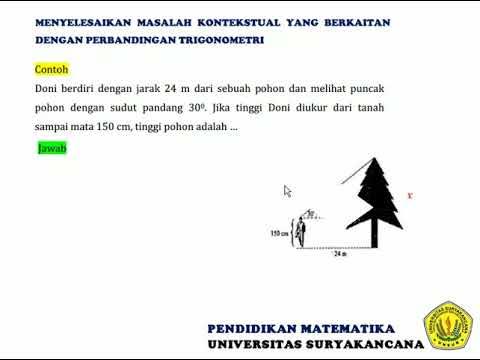CARA MENGHITUNG TINGGI TIANG BENDERA DENGAN MENGGUNAKAN RUMUS TRIGONOMETRI #trigonometry #matematika
Summary
TLDRIn this educational video, the presenter introduces a practical application of trigonometry to calculate the height of a flagpole. The method involves using basic tools such as a measuring tape, a protractor, and two observers of the same height. By measuring the distance and the angle of elevation from both observers, the script guides viewers through the process of calculating the flagpole's height using trigonometric functions like tangent. The final height of the flagpole is determined to be approximately 9.43 meters, demonstrating the real-world utility of trigonometry.
Takeaways
- 😀 The script introduces the concept of using trigonometry to calculate the height of a flagpole.
- 😀 Trigonometry is a branch of mathematics that studies the relationship between angles and sides in a triangle.
- 😀 The word 'trigonometry' comes from Greek: 'trigonum' meaning three angles and 'metron' meaning measure.
- 😀 To perform the measurement, tools like a meter, protractor, notebook, pen, and two observers are required.
- 😀 The height of the first observer is measured as 1.63 meters, and the distance between the two observers is 3.60 meters.
- 😀 The first observer measures the angle of elevation to the top of the flagpole as 60°, while the second observer measures it as 45°.
- 😀 The height of the flagpole is represented by 'T' and the height from the ground to the observer's level is 't'.
- 😀 Using the tangent function (Tan), the height of the flagpole is calculated from the angle measurements and distances.
- 😀 The first equation using Tan for the first observer yields the height of the flagpole as 7.8 meters.
- 😀 The second equation, based on the second observer's angle, confirms the height of the flagpole to be 7.8 meters as well.
- 😀 By adding the height of the observer (1.63 meters) to the flagpole's calculated height, the total height of the flagpole becomes 9.43 meters.
Q & A
What is the main objective of the script?
-The main objective of the script is to demonstrate how to calculate the height of a flagpole using trigonometric formulas.
What is trigonometry and why is it relevant in this script?
-Trigonometry is a branch of mathematics that studies the relationships between the angles and sides of triangles. It is relevant here because it is used to calculate the height of the flagpole based on angles and distances.
What tools are necessary to perform the height calculation in the script?
-The tools necessary for the calculation are a measuring tape, a protractor, a notebook, a pen, and two observers of equal height.
How is the height of the first observer measured?
-The height of the first observer is measured using a measuring tape and is found to be 1.63 meters (or 163 cm).
What distance separates the two observers?
-The distance between the two observers is 3.60 meters (or 360 cm).
What is the first observer's angle of elevation?
-The first observer measures an angle of elevation of 60° when observing the flagpole.
What is the second observer's angle of elevation?
-The second observer measures an angle of elevation of 45° when observing the flagpole.
What is the relationship between the distances and angles used in the calculation?
-The distances and angles are related through trigonometric functions. Specifically, the tangent of the angle (tan) is used to calculate the height of the flagpole based on the known distances.
How is the height of the flagpole calculated in the script?
-The height of the flagpole is calculated by solving two equations based on the tangent of the angles of elevation. The first equation uses tan(60°), and the second uses tan(45°). By substituting and solving the equations, the height is found to be 7.8 meters.
What is the total height of the flagpole when including the observer's height?
-The total height of the flagpole, including the observer's height, is calculated to be 9.43 meters, where the flagpole height is 7.8 meters, and the observer’s height is 1.63 meters.
Outlines

This section is available to paid users only. Please upgrade to access this part.
Upgrade NowMindmap

This section is available to paid users only. Please upgrade to access this part.
Upgrade NowKeywords

This section is available to paid users only. Please upgrade to access this part.
Upgrade NowHighlights

This section is available to paid users only. Please upgrade to access this part.
Upgrade NowTranscripts

This section is available to paid users only. Please upgrade to access this part.
Upgrade NowBrowse More Related Video

Menghitung Tinggi Menara Dengan Bayangannya

Membuat Alat Klinometer dan Penggunaan Alat Peraga Klinometer

FREE FALL PHYSICS PERFORMANCE TASK

Kekongruenan dan Kesebangunan [Part 4] - Kesebangunan Dua Segitiga

Perbandingan Trigonometri: Pembahasan Soal Cerita

Vektor Fisika • Part 1: Pengantar Trigonometri Dasar
5.0 / 5 (0 votes)